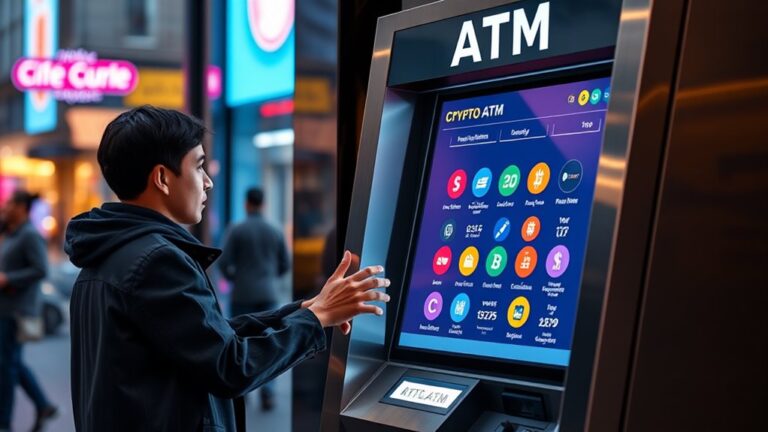
Cross-Border Crypto Transactions: Benefits of Blockchain for Global Payments
Blockchain technology transforms cross-border cryptocurrency transactions by greatly enhancing speed and reducing costs. It allows for direct peer-to-peer payments, minimizing reliance on intermediaries and thereby lowering transaction fees to 1% or less. Enhanced transparency and security features, such as immutable ledgers and smart contracts, foster trust among users. Additionally, blockchain expands access to financial services in underserved regions. These advantages come alongside regulatory challenges, influencing how businesses navigate the landscape of global payments. More details await further exploration.
Key Takeaways
- Blockchain technology facilitates direct peer-to-peer transactions, significantly reducing processing times and transaction costs for cross-border payments.
- Enhanced transparency through an immutable ledger allows for real-time tracking, fostering trust among all transaction participants.
- Cryptocurrencies lower transaction fees from traditional 3-5% to 1% or less, making global payments more affordable for businesses and consumers.
- The decentralized structure of blockchain eliminates intermediaries, enhancing security and resilience while streamlining the payment process.
- Blockchain expands access to financial services, particularly in underserved regions, promoting economic inclusion and global market participation.
Speed and Cost Reduction in Cross-Border Payments

In recent years, the landscape of cross-border payments has undergone significant transformation, primarily due to advancements in blockchain technology. Traditional methods often involve multiple intermediaries, leading to slow processing times and high fees.
Conversely, blockchain allows for direct peer-to-peer transactions, eliminating these intermediaries and enhancing both speed and cost efficiency. Cryptocurrencies, such as Bitcoin and Ethereum, provide faster transaction speeds and lower fees, often reducing costs from 3-5% to 1% or less.
Additionally, blockchain’s real-time processing capabilities can settle payments in minutes instead of days. This efficiency improves cash flow for businesses, enabling them to operate more effectively while benefiting from lower transaction fees. Moreover, the rise of stablecoins in payments is further enhancing the reliability and efficiency of cross-border transactions, making them an essential tool in the global financial landscape.
Enhanced Transparency and Security Features

Enhanced transparency and security features are essential components of blockchain technology, especially in the domain of cross-border crypto transactions. Blockchain offers an immutable ledger, guaranteeing that all transactions are recorded transparently and can be audited by participants. Each transaction is timestamped and verified, enhancing accountability. Unlike traditional systems that rely on intermediaries, blockchain allows for real-time tracking, fostering trust. Security measures, such as advanced encryption and decentralized consensus, protect against fraud. Additionally, smart contracts can facilitate automatic fraud detection. Notably, as regulatory frameworks evolve, they increasingly emphasize consumer protection, which aligns with the security features of blockchain technology. The following table summarizes these features:
| Feature | Description |
|---|---|
| Immutable Ledger | Guarantees transparency and prevents data manipulation |
| Real-Time Tracking | Enhances accountability and trust |
| Advanced Encryption | Protects sensitive information from unauthorized access |
| Decentralized Consensus | Reduces vulnerabilities associated with centralization |
| Smart Contracts | Automatically detects fraud and verifies transactions |
Expanding Access to Global Markets

As blockchain technology continues to evolve, it plays an essential role in expanding access to global markets, particularly for individuals and businesses in regions where traditional banking systems are limited.
This technology allows for cross-border payments without the need for intermediaries, resulting in faster and more affordable transactions. Approximately 650 million people globally own cryptocurrency, with many interested in using it for purchases.
Importantly, major brands now accept cryptocurrencies, attracting customers who tend to spend more than those using traditional methods. Additionally, businesses accepting cryptocurrencies are leading the way in demonstrating the potential of digital currencies in everyday transactions.
Furthermore, blockchain offers solutions for underserved populations by providing easier access to financial services, thereby enhancing economic inclusion.
As a result, the global adoption of cryptocurrencies is steadily increasing, indicating a shift towards greater financial participation.
Technical Advantages of Blockchain Technology

Blockchain technology offers several technical advantages that enhance its appeal for cross-border transactions and beyond.
Its decentralized structure eliminates central points of failure, improving resilience and data integrity. Transactions are recorded across a distributed network, fostering trust among participants while enhancing security. The immutable nature of blockchain guarantees that once a transaction is recorded, it cannot be altered, providing a permanent record.
Additionally, transactions benefit from end-to-end encryption, protecting them from unauthorized access. Blockchain’s speed and efficiency are notable, with faster processing times and 24/7 operational capability. Furthermore, the technology’s ability to securely verify transactions contributes to reducing fraud and errors in global payment systems.
Finally, the elimination of intermediaries reduces costs, making it a financially attractive option for businesses engaging in global payments.
Navigating Regulatory Challenges in Crypto Transactions

Maneuvering the regulatory landscape surrounding crypto transactions presents significant challenges for businesses and investors alike. In the United States, regulations vary between federal agencies like the SEC and CFTC, along with state-specific licensing rules. This fragmented framework creates confusion about whether cryptocurrencies are classified as securities or commodities.
Additionally, businesses face strict Anti-Money Laundering (AML) requirements overseen by FinCEN, further complicating compliance. Internationally, organizations like FATF work to establish global standards, but discrepancies persist. Some countries adopt comprehensive frameworks while others remain cautious, affecting how cross-border transactions are handled.
As market volatility and cybersecurity threats increase, regulators emphasize consumer protection. To navigate these complexities, companies must stay informed about changing laws and consider technological solutions for compliance, ensuring they meet both current and future regulatory demands in the evolving crypto landscape.
Frequently Asked Questions
How Do Cryptocurrencies Impact Exchange Rates in Cross-Border Transactions?
Cryptocurrencies influence exchange rates in cross-border transactions through their volatility, market demand, and supply dynamics. Pricing shifts can attract investors, impacting traditional currencies and altering capital flows in unpredictable economic conditions.
What Are the Environmental Impacts of Blockchain Technology?
Blockchain technology considerably impacts the environment through high energy consumption, carbon emissions, and electronic waste generation. Its reliance on proof-of-work mechanisms exacerbates these issues, prompting exploration of alternative consensus methods and renewable energy solutions for sustainability.
How Can Businesses Protect Against Crypto Volatility?
In a world reminiscent of gold rushes, businesses can mitigate crypto volatility through diversification, stop-loss orders, and advanced options. Implementing market indicators and maintaining regulatory awareness further protects investments from unpredictable price swings.
What Are the Tax Implications of Cross-Border Crypto Transactions?
Cross-border crypto transactions entail complex tax implications, requiring accurate reporting of gains and losses. Jurisdictional variations complicate compliance, making thorough understanding of local regulations essential to avoid penalties and guarantee proper tax management.
How Does User Experience Differ Between Traditional and Blockchain Payment Systems?
User experience diverges greatly between traditional and blockchain payment systems; familiarity aids traditional methods, while blockchain’s complexity can intimidate. Simplified interfaces and educational tools are essential for bridging understanding gaps, ensuring smoother transactions for new users.
Conclusion
To summarize, cross-border crypto transactions present significant advantages for global payments, including speed, cost efficiency, and enhanced security. As blockchain technology evolves, it offers new opportunities for businesses and individuals alike to access international markets with greater ease. However, maneuvering regulatory challenges remains essential. Will the benefits of this innovative technology outweigh the complexities of compliance? As the global financial landscape shifts, the potential for blockchain to transform cross-border payments is both promising and worth exploring.












